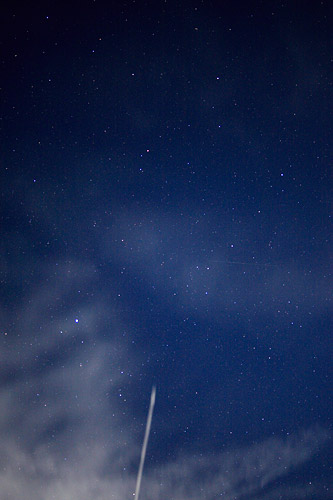Focusing on infinity / shooting stars
One thing many photographers don’t realize is that there is no such thing as a fixed infinity focus, especially with modern lenses using “ED” or fluorite or “low dispersion” glass elements. Many Nikon or Canon zoom lenses shows an infinity mark, but actual infinity focus might be before or after that mark, depending on the temperature.
The same is true even for prime (non zoom) lenses, and even for lenses designed decades ago (though usually less so). The infinity “stop” found on manual-focus lenses needs to be set slightly beyond infinity to allow for the shift in infinity focus with changing temperatures. As a consequence, the convenient approach of racking the focusing ring to the infinity focus mark until it physically stops might well focus beyond infinity, leading to blurry results.
This unfortunate fact leads to a real problem for astrophotography: how does one ensure that the stars are actually in focus? With the Canon EOS 1D Mark III and a visibly bright star, this is no problem; use the Live View feature and nail the focus exactly. With lesser cameras, it’s trial and error, taking a frame and using the LCD to zoom in until infinity focus is found—call it “LCD zoom focus”...a tricky business if the lens doesn’t image sharply-defined points.
Another problem with many lenses is coma of various kinds, such as sagittal coma flare, claimed to be well-corrected in such lenses as the aspheric NOCT-Nikkor 58mm f/1.2. In spite of idiotic claims to the contrary, the NOCT-Nikkor is an exceptionally poor choice for astrophotography—the poor degree of aberration correction is blatantly evident, along with strong field curvature. Once one tries to actually photograph a starry sky with it, the results can be seen to be dismal, easily bested by the ordinary 50mm f/1.4D. (I’ve tried 4 samples of the NOCT-Nikkor).
The more recently-designed Canon 35mm f/1.4L also suffers from uncorrected aberrations, turning points of light into smears that can look like a bird’s wings; this requires stopping down to eliminate them, defeating the purpose of an f/1.4 lens. It also suffers from uncorrected spherical aberration.
By comparison with the latter two very expensive lenses, the Zeiss 35mm f/2 ZF lens shows great promise as an astrophotography lens because it has a high degree of correction for off-axis aberrations. Wide open at f/2 out to the corners (on the Canon 1D Mark III), points of light (stars) are points, not blobs with wings as seen with the Canon 35mm f/1.4L. (No, I didn’t shoot the image below with film; the horizontal streak is a meteor not a faint scratch on film!)

Yosemite sky at 10,000' [larger]
Canon EOS 1D Mark III, Zeiss 35mm f/2 @ f/2, ISO 800, 10 sec




























